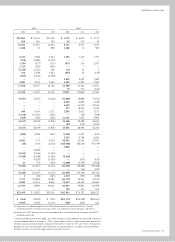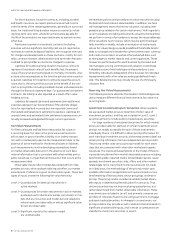GE 2012 Annual Report Download - page 81
Download and view the complete annual report
Please find page 81 of the 2012 GE annual report below. You can navigate through the pages in the report by either clicking on the pages listed below, or by using the keyword search tool below to find specific information within the annual report. GE 2012 ANNUAL REPORT 79
notes to consolidated financial statements
Losses on Financing Receivables
Losses on financing receivables are recognized when they are
incurred, which requires us to make our best estimate of probable
losses inherent in the portfolio. The method for calculating the
best estimate of losses depends on the size, type and risk char-
acteristics of the related financing receivable. Such an estimate
requires consideration of historical loss experience, adjusted for
current conditions, and judgments about the probable effects of
relevant observable data, including present economic conditions
such as delinquency rates, financial health of specific customers
and market sectors, collateral values (including housing price
indices as applicable), and the present and expected future levels
of interest rates. The underlying assumptions, estimates and
assessments we use to provide for losses are updated periodi-
cally to reflect our view of current conditions and are subject to
the regulatory examination process, which can result in changes
to our assumptions. Changes in such estimates can significantly
affect the allowance and provision for losses. It is possible that we
will experience credit losses that are different from our current
estimates. Write-offs are deducted from the allowance for losses
when we judge the principal to be uncollectible and subsequent
recoveries are added to the allowance at the time cash is received
on a written-off account.
“Impaired” loans are defined as larger balance or restructured
loans for which it is probable that the lender will be unable to col-
lect all amounts due according to the original contractual terms
of the loan agreement.
“Troubled debt restructurings” (TDRs) are those loans for
which we have granted a concession to a borrower experiencing
financial difficulties where we do not receive adequate compen-
sation. Such loans are classified as impaired, and are individually
reviewed for specific reserves.
“Nonaccrual financing receivables” are those on which we
have stopped accruing interest. We stop accruing interest at the
earlier of the time at which collection of an account becomes
doubtful or the account becomes 90 days past due. Although
we stop accruing interest in advance of payments, we recognize
interest income as cash is collected when appropriate provided
the amount does not exceed that which would have been earned
at the historical effective interest rate. Recently restructured
financing receivables are not considered delinquent when pay-
ments are brought current according to the restructured terms,
but may remain classified as nonaccrual until there has been a
period of satisfactory payment performance by the borrower and
future payments are reasonably assured of collection.
“Nonearning financing receivables” are a subset of nonaccrual
financing receivables for which cash payments are not being
received or for which we are on the cost recovery method of
accounting (i.e., any payments are accounted for as a reduc-
tion of principal). This category excludes loans purchased at
a discount (unless they have deteriorated post acquisition).
Under Financial Accounting Standards Board (FASB) Accounting
Standards Codification (ASC) 310, Receivables, these loans are
initially recorded at fair value and accrete interest income over
the estimated life of the loan based on reasonably estimable cash
flows even if the underlying loans are contractually delinquent
at acquisition.
“Delinquent” receivables are those that are 30 days or more
past due based on their contractual terms.
The same financing receivable may meet more than one of the
definitions above. Accordingly, these categories are not mutually
exclusive and it is possible for a particular loan to meet the defi-
nitions of a TDR, impaired loan, nonaccrual loan and nonearning
loan and be included in each of these categories. The categoriza-
tion of a particular loan also may not be indicative of the potential
for loss.
Our consumer loan portfolio consists of smaller-balance,
homogeneous loans, including credit card receivables, install-
ment loans, auto loans and leases and residential mortgages. We
collectively evaluate each portfolio for impairment quarterly. The
allowance for losses on these receivables is established through
a process that estimates the probable losses inherent in the
portfolio based upon statistical analyses of portfolio data. These
analyses include migration analysis, in which historical delin-
quency and credit loss experience is applied to the current aging
of the portfolio, together with other analyses that reflect current
trends and conditions. We also consider our historical loss experi-
ence to date based on actual defaulted loans and overall portfolio
indicators including nonearning loans, trends in loan volume and
lending terms, credit policies and other observable environmen-
tal factors such as unemployment rates and home price indices.
Our commercial loan and lease portfolio consists of a variety of
loans and leases, including both larger-balance, non-homogeneous
loans and leases and smaller-balance homogeneous loans and
leases. Losses on such loans and leases are recorded when prob-
able and estimable. We routinely evaluate our entire portfolio for
potential specific credit or collection issues that might indicate
an impairment.
For larger-balance, non-homogeneous loans and leases,
we consider the financial status, payment history, collateral
value, industry conditions and guarantor support related to
specific customers. Any delinquencies or bankruptcies are indi-
cations of potential impairment requiring further assessment
of collectibility. We routinely receive financial as well as rating
agency reports on our customers, and we elevate for further
attention those customers whose operations we judge to be
marginal or deteriorating. We also elevate customers for further
attention when we observe a decline in collateral values for asset-
based loans. While collateral values are not always available,
when we observe such a decline, we evaluate relevant markets to
assess recovery alternatives—for example, for real estate loans,
relevant markets are local; for commercial aircraft loans, relevant
markets are global.
Measurement of the loss on our impaired commercial loans
is based on the present value of expected future cash flows dis-
counted at the loan’s effective interest rate or the fair value of
collateral, net of expected selling costs, if the loan is determined to
be collateral dependent. We determine whether a loan is collateral
dependent if the repayment of the loan is expected to be provided
solely by the underlying collateral. Our review process can often
result in reserves being established in advance of a modification of
terms or designation as a TDR. After providing for specific incurred
losses, we then determine an allowance for losses that have been
incurred in the balance of the portfolio but cannot yet be identi-
fied to a specific loan or lease. This estimate is based upon various
























